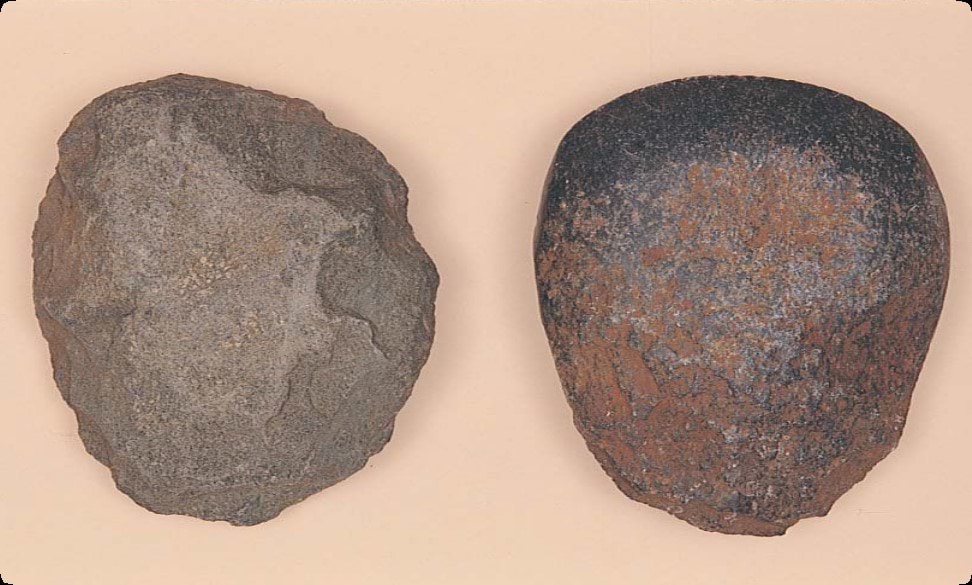Characteristics
- ground-edge axes come in different shapes, but they are usually either round or oval. They are sometimes rounded and narrow at one end, and slightly broader and straighter at the cutting edge
- most are 50–200 millimetres long, 40 to 100 millimetres wide and 20 to 60 millimetres thick
- typically ‘lens shaped’ when viewed from the side
- made from hard types of stone, particularly basalt or greenstone, and worn river pebbles
- may have one or more ground cutting edges, and they may be polished smooth all over
- ground surfaces are usually highly polished
- may have a groove pecked around their ‘waist’ so it is easier to attach a handle
Complete axes are rare. It is more common to find smaller, broken, polished fragments.
What are Aboriginal ground-edge axes?
Ground-edge axes are stone chopping tools with cutting edges that were formed by grinding. They were often designed to have a handle. Aboriginal ground-edge axes are usually rounded or oval in shape, but may be slightly elongated with a straighter, sharpened end.
Where are they found?
Ground-edge axes can be found almost anywhere where Aboriginal people camped or lived in Victoria. They may be found near axe-grinding grooves, axe quarries or burial sites.
How did Aboriginal people make ground-edge axes?
Aboriginal people made ‘axe blanks’ by striking large flakes of stone from rocky outcrops, then roughly shaping them. They carried axe blanks across great distances for trading.
The axes were often finished away from the quarry. The tool maker would complete an axe by grinding to make a sharp cutting edge.
This edge, while not as sharp as a chipped stone tool, was much more durable.
When the edge was broken or chipped, the axe could be sharpened again and again. Grinding was usually done on sandstone outcrops, often leaving deep grooves. Sometimes the whole axe was ground to a smooth glossy finish.
Aboriginal people often used natural resin and plant fibre or kangaroo sinew to attach the axe to a short wooden handle.
How did Aboriginal people use ground-edge axes?
Aboriginal people used axes to cut down small trees, chop wood, remove tree bark for canoes and shelters, butcher larger animals and undertake many other tasks. They also used axes as weapons, ceremonial objects and valuable trade items.
Many axes come from a large greenstone quarry at Mount William (Wil-im-ee Mooring), near Lancefield. Axes from this quarry have been found up to 800 kilometres from Mount William, but not in the eastern half of Victoria.
The Gunaikurnai people in the east had their own quarries and system of trade. Studies of the distribution of Mount William (Wil-im-ee Mooring) axes have demonstrated that this trade boundary existed for a long time, possibly several thousand years.
What natural rocks look similar to ground-edge axes?
Ground-edge axes are easy to distinguish from natural rocks. Smooth, hard, river pebbles may look like the axes, but they do not have the sharp edges.
Why are ground-edge axes important?
Aboriginal ground-stone axes are an important link for Aboriginal people today with their culture and their past. We know of the custodians of some quarries where stone axes were made, and their descendants are still alive today.
The axes are a valuable source of information about the past way of life of Aboriginal people.
Are Aboriginal ground-edge axes under threat?
Ground-edge axes are strong and durable. Unfortunately, because they are obviously Aboriginal artefacts, many have been taken by artefact collectors and the general public.
We know little about these collected axes: information about their age, original location and links with other artefacts has been lost forever.
Natural processes such as wind and water erosion may disturb axes, but human interference such as ploughing and development (and particularly souvenir collecting) poses the greatest threat to these artefacts.
First Peoples - State Relations records the location, dimensions and condition of Aboriginal ground-edge axes. The aim is to have a permanent written and photographic record of this important part of the heritage of all Australians.
Are Aboriginal ground-edge axes protected?
The law protects all Aboriginal cultural places and artefacts in Victoria. It is illegal to disturb or destroy an Aboriginal place.
Ground-edge axes and other artefacts should not be removed from site.
It is also illegal to sell artefacts without a cultural heritage permit. Information about permits may be obtained from First Peoples - State Relations.
What to do if you find a ground-edge axe?
- do not disturb or remove it
- check whether the object has the typical characteristics of an Aboriginal ground-edge axe
- if it does, record its location and write a brief description of its condition
- note whether it is under threat of disturbance.
Please help to preserve Aboriginal cultural places by reporting their presence to First Peoples - State Relations.
Updated



